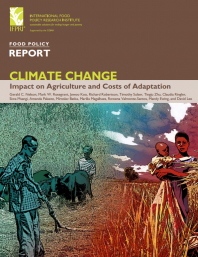
Climate Change: Impact on Agriculture and Costs of Adaptation

Executive Summary (excerpt)
The Challenge
The unimpeded growth of greenhouse gas emissions is raising the earth’s temperature. The consequences include melting glaciers, more precipitation, more and more extreme weather events, and shifting seasons. The accelerating pace of climate change, combined with global population and income growth, threatens food security everywhere.
Agriculture is extremely vulnerable to climate change. Higher temperatures eventually reduce yields of desirable crops while encouraging weed and pest proliferation. Changes in precipitation patterns increase the likelihood of short-run crop failures and long-run production declines. Although there will be gains in some crops in some regions of the world, the overall impacts of climate change on agriculture are expected to be negative, threatening global food security.
Populations in the developing world, which are already vulnerable and food insecure, are likely to be the most seriously affected. In 2005, nearly half of the economically active population in developing countries—2.5 billion people—relied on agriculture for its livelihood. Today, 75 percent of the world’s poor live in rural areas.
This Food Policy Report presents research results that quantify the climate-change impacts mentioned above, assesses the consequences for food security, and estimates the investments that would offset the negative consequences for human well-being. This analysis brings together, for the first time, detailed modeling of crop growth under climate change with insights from an extremely detailed global agriculture model, using two climate scenarios to simulate future climate. The results of the analysis suggest that agriculture and human well-being will be negatively affected by climate change.
- Issues:
- Climate Change, Natural Resources
- Region:
- Global
- Year Published:
- 2009
- Authors:
- Mark W. Rosegrant, Gerald C. Nelson, Jawoo Koo, Richard Robertson, Timothy Sulser, Tingju Zhu, Claudia Ringler, Siwa Msangi, Amanda Palazzo, Miroslav Batka, Marilia Magalhaes, Rowena Valmonte-Santo, Mandy Ewing, David Lee
- Institution:
- International Food Policy Research Institute (IFPRI)

